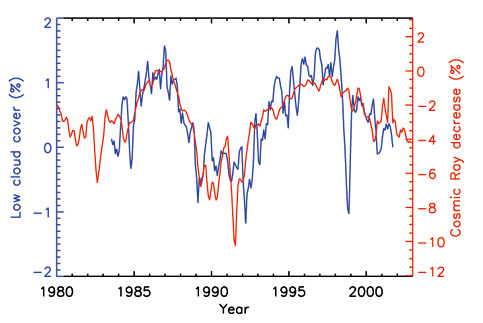Carbon Dioxide or Solar Forcing?
[FONT=&]". . . Today, there is ample evidence to support this picture (a succinct introduction can be found [/FONT]
here[FONT=&]). For example, it was found that independent galactic induced variations in the cosmic ray flux, which have nothing to do with solar activity do too [/FONT]
affect climate[FONT=&] as one should expect from such a link. There are many more examples. [/FONT]
[Added Note (4 Oct. 2006): These recently published experimental resultsstrongly point towards the validity of this link, as expected] . . . "
Cosmic Rays and Climate
[FONT=&]". . . Clouds have been observed from space since the beginning of the 1980's. By the mid 1990's, enough cloud data accumulated to provide empirical evidence for a solar/cloud-cover link. Without the satellite data, it hard or probably impossible to get statistically meaningful results because of the large systematic errors plaguing ground based observations. Using the satellite data, Henrik Svensmark of the Danish National Space Center in Copenhagen has shown that cloud cover varies in sync with the variable cosmic ray flux reaching the Earth. Over the relevant time scale, the largest variations arise from the 11-yr solar cycle, and indeed, this cloud cover seemed to follow the cycle and a half of cosmic ray flux modulation. Later, Henrik Svensmark and his colleague Nigel Marsh, have shown that the correlation is primarily with low altitude cloud cover. This can be seen in fig. 3.[/FONT]
[FONT=&]
Figure 3: The correlation between cosmic ray flux (orange) as measured in Neutron count monitors in low magnetic latitudes, and the low altitude cloud cover (blue) using ISCCP satellite data set, following Marsh & Svensmark, 2003.
[/FONT]
[FONT=&]The solar-activity – cosmic-ray-flux – cloud-cover correlation is quite apparent. It was in fact sought for by Henrik Svensmrk, based on theoretical considerations. However, by itself it cannot be used to prove the cosmic ray climate connection. The reason is that we cannot exclude the possibility that solar activity modulates the cosmic ray flux and independently climate, without any casual link between the latter two. There is however separate proof that a casual link exists between cosmic rays and climate, and independently that cosmic rays left a fingerprint in the observed cloud cover variations.
[/FONT][FONT="]To begin with, climate variations appear to arise also from intrinsic cosmic ray flux variations, namely, from variations that have nothing to do with solar activity modulations. This removes any doubt that the observed solar activity cloud cover correlations are coincidental or without an actual causal connection. That is to say, it removes the possibility that solar activity modulates the cosmic ray flux and independently the climate, such that we [/FONT][FONT="]
think[/FONT][FONT="] that the cosmic rays and climate are related, where in fact they are not. Specifically, cosmic ray flux variations also arise from the varying environment around the solar system, as it journeys around the Milky Way. These variations appear to have left a paleoclimatic imprint in the geological records. [/FONT][FONT=&]. . ."[/FONT]



